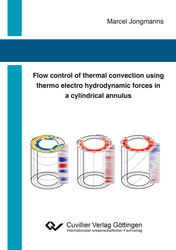| Fachbereiche | |
|---|---|
| Buchreihen (96) |
1378
|
| Nachhaltigkeit |
3
|
| Gesundheitswesen |
1
|
| Geisteswissenschaften |
2364
|
| Naturwissenschaften |
5406
|
| Ingenieurwissenschaften |
1793
|
| Allgemeine Ingenieurwissenschaften | 292 |
| Maschinenbau und Verfahrenstechnik | 862 |
| Elektrotechnik | 686 |
| Bergbau- und Hüttenwesen | 30 |
| Architektur und Bauwesen | 75 |
| Allgemein |
98
|
|
Leitlinien Unfallchirurgie
5. Auflage bestellen |
|
Erweiterte Suche
Flow control of thermal convection using thermo electro hydrodynamic forces in a cylindrical annulus
Marcel Jongmanns (Autor)Vorschau
Inhaltsverzeichnis, PDF (34 KB)
Leseprobe, PDF (880 KB)
The main topic of this thesis is the influence of the dielectrophoretic (DEP) force on a thermal convection in a cylindrical annulus under microgravity conditions of parabolic flights. To perform these experiments a specialized experimental setup was designed. The annulus is differentially heated to create a temperature gradient and an ac voltage of up to 10kV is applied. Two different experiment setups were build for different measurement methods. One for Shadowgraph and Synthetic Schlieren methods and the other for PIV measurements. Several complex flow patterns can be identified by combining the resulting images from both visualization mthods. The heat transfer is determined under different experimental conditions. Under the given conditions it is possible to make a correlation between the flow patterns and the level of the convective heat transfer. The experimental data is compared to theoretical data from a linear stability analysis. The patterns predicted by the can also found in the experiments.
| ISBN-13 (Printausgabe) | 9783736970441 |
| ISBN-13 (E-Book) | 9783736960442 |
| Buchendformat | A5 |
| Sprache | Englisch |
| Seitenanzahl | 176 |
| Umschlagkaschierung | matt |
| Auflage | 1. |
| Erscheinungsort | Göttingen |
| Erscheinungsdatum | 08.07.2019 |
| Allgemeine Einordnung | Dissertation |
| Fachbereiche |
Ingenieurwissenschaften
|
| Schlagwörter | Fluidmechanik, Strömungslehre, Thermo-Elektrohydrodynamik, Thermo- Elektrohydrodynamik Kraft, Zylinderspalt, Annulus, Dielektrophoretische Kraft, Dielektrophorese, Schwerelosigkeit, Wärmetransport, Thermische Konvektion, Künstliche Schwerkraft, Dielektrische Flüssigkeit, Dielektrikum, Silikonöl, Hochspannung, Elektrisches Feld, Parabelflüge, Raumfahrtanwendung, Strömungszustände, Strömungsmuster, Fluid mechanics, thermo-electrohydrodynamics, thermo-electrohydrodynamic force, cylindrical gap, annulus, dielectrophoretic force, microgravity, heat transfer, thermal convection, artifical gravity, dielectric fluid, dielectric, silicone oil, high-voltage, electric field, parabolic flights, space application, flow state, flow pattern |








